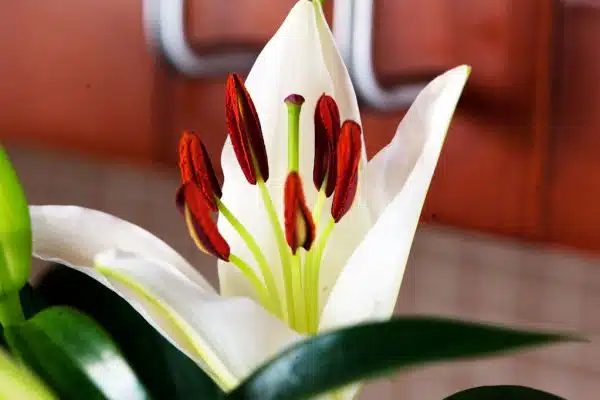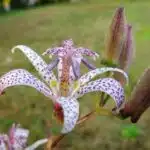The Casa Blanca Lily, also known as the Lilium candidum, is a stunning and fragrant flower that is highly sought after by gardening enthusiasts. Originating from the Mediterranean region, this lily has been cultivated for centuries due to its elegance and beauty. Growing and caring for this plant requires attention to detail and proper maintenance to ensure that it thrives in its environment.
As a horticulturist or gardening expert, it is essential to understand the intricacies of growing and caring for the Casa Blanca Lily. This article aims to provide readers with an in-depth guide on how to cultivate this beautiful plant successfully. From selecting the right soil type to maintaining optimal water levels, this guide will equip gardeners with all they need to know about growing and caring for the Casa Blanca Lily. By following these tips, readers can confidently bring this elegant flower into their gardens and serve others with its beauty.
Overview Of The Casa Blanca Lily
Casa Blanca Lily is a beautiful and popular flower that belongs to the true lily family, Liliaceae. This perennial plant is native to Taiwan and was introduced in North America in the early 20th century. The Casa Blanca Lily is well-known for its large, fragrant white flowers that can grow up to ten inches in diameter.
There are several varieties of Casa Blanca Lily available, including Asiatic hybrids, Oriental hybrids, Trumpet hybrids, and Longiflorum hybrids. Each variety has its unique characteristics such as flower size, fragrance, color shade, and foliage. Some popular varieties of Casa Blanca Lily are White Heaven, Regale Album, Pink Perfection, and Golden Splendour.
The Casa Blanca Lily symbolizes purity, innocence, and devotion. It is often used for wedding bouquets or as a gift on special occasions. In ancient times, it was believed that the scent of this flower could ward off evil spirits. Today it is still considered an auspicious flower in many cultures around the world. Understanding the symbolism and meaning of this plant adds to its appeal and makes it a great choice for any garden or landscaping project.
To properly care for your Casa Blanca Lily plant requires knowledge of its growth cycle. Understanding when to plant it outdoors or indoors depending on your geographic area will play a significant role in ensuring healthy growth patterns throughout various seasons.
Understanding The Plant’s Growth Cycle
- The Casa Blanca lily is a prominent species of lily cultivated for its large, fragrant white blooms.
- Seed germination of the Casa Blanca lily is achieved through the use of a moist, well-draining soil medium, with ideal temperatures ranging from 20 to 25 degrees Celsius.
- Proper bulb care for the Casa Blanca lily involves planting the bulb in a sunny location with nutrient rich soil and maintaining adequate levels of moisture throughout the growing season.
- Flower development of the Casa Blanca lily is triggered by changes in day length, with blooms typically appearing in late spring or early summer.
- To promote healthy growth, the Casa Blanca lily must receive adequate levels of sunlight and fertilizer throughout its flowering period.
- Lastly, to ensure that the Casa Blanca lily remains healthy and continues to bloom, deadheading of spent blooms is essential.
Seed Germination
The Casa Blanca lily is a beautiful and fragrant flower that can be grown through hydroponic growing or natural propagation techniques. Seed germination is an essential part of the plant’s growth cycle, and it can be a challenging process for some gardeners. To start, you need to select high-quality seeds that are free from any damage or disease. These seeds should be planted in well-draining soil and kept moist until germination occurs.
Hydroponic growing is an effective way to propagate Casa Blanca lilies as it allows for better control over the environment in which the plants grow. This method involves growing plants without soil, using nutrient-rich water instead. Seeds can be placed in a hydroponic system where they will receive adequate moisture, nutrients, and light to promote growth. The downside of this method is that it requires specialized equipment and knowledge of hydroponics.
Natural propagation techniques involve planting the seeds directly into well-prepared soil beds or pots. It is crucial to keep the soil moist but not wet during the germination process to avoid rotting of the seedlings. Once the seedlings have sprouted, they should be thinned out so that each plant has enough space to grow properly. In conclusion, whether you choose hydroponic growing or natural propagation techniques, understanding seed germination is crucial for successful Casa Blanca lily cultivation.
Bulb Care
Understanding the plant’s growth cycle is essential to ensure a healthy and beautiful Casa Blanca lily. In addition to seed germination, another critical aspect of plant care is bulb maintenance. Bulbs are the underground storage organs that contain all the nutrients necessary for the plant’s growth and survival. Proper bulb care involves storing bulbs correctly and ensuring adequate propagation.
Storing bulbs is an essential step in maintaining their quality and viability. It is best to store bulbs in a cool, dry place with good air circulation. Bulbs should be carefully inspected for any signs of disease or damage before storage, as this can affect their ability to sprout. Labeling the bulbs with their species name and planting date can help keep track of them during storage.
Bulb propagation involves separating small offsets from the parent bulb and replanting them in well-prepared soil beds or pots. This method ensures that new plants have similar characteristics to the parent plant, resulting in consistent blooms every year. It is crucial to handle bulbs gently during propagation as they are delicate and susceptible to damage. After planting, it is important to water them regularly but not overwater as this can cause rotting.
Understanding bulb care is crucial for successful Casa Blanca lily cultivation. Proper storage techniques help maintain their quality while propagation ensures consistent blooms every year. With careful attention to detail and consistent monitoring, gardeners can enjoy these beautiful flowers for years to come.
Flower Development
Understanding the plant’s growth cycle is essential in cultivating a healthy and vibrant garden. One critical aspect of this cycle is flower development, which involves the pollination techniques and genetic modifications required to produce beautiful blooms. Pollination can occur through self-pollination, cross-pollination, or assisted pollination, depending on the plant species.
Genetic modifications also play a vital role in flower development, particularly in creating cultivars with desirable traits such as disease resistance, larger blooms, or different colors. These modifications can be achieved through breeding or genetic engineering techniques. However, it is essential to consider the potential risks and benefits associated with genetic modifications before implementing them in gardening practices.
In conclusion, understanding flower development is crucial in achieving successful plant growth and cultivation. By utilizing proper pollination techniques and considering genetic modification options, gardeners can produce vibrant blooms that are both aesthetically pleasing and genetically stable for future planting seasons.
Selecting The Right Location For Planting
When selecting a location to plant your Casa Blanca Lily, it is important to consider the amount of sunlight the plant will receive. These lilies require full sun exposure for at least six hours a day. If you are planting indoors, place them near a bright window that receives direct sunlight. Outdoors, choose a spot that is not shaded by trees or other plants.
Another factor to consider when selecting a planting location is soil pH. The ideal soil pH range for Casa Blanca Lilies is between 6.0 and 7.0. Use a soil testing kit to determine the pH level of your soil before planting your lilies. If the pH level falls outside of this range, adjust it by adding amendments such as lime or sulfur.
To further assist you in selecting the right location for your Casa Blanca Lily, refer to the following table:
| Sunlight Requirements | Soil pH Range |
|---|---|
| Full sun exposure for at least six hours daily | 6.0-7.0 |
By following these guidelines and choosing an appropriate location with adequate sunlight and proper soil pH balance, you can ensure healthy growth and blooming of your Casa Blanca Lilies. In the subsequent section, we will discuss how to prepare and fertilize the soil for optimal growth and health of your plants.
Soil Preparation And Fertilization
Soil preparation and fertilization are two essential steps in growing a healthy and blooming Casa Blanca Lily. Before planting, it is important to prepare the soil by removing any weeds or debris and loosening the soil to a depth of at least 12 inches. The Casa Blanca Lily thrives in well-draining soil that is rich in organic matter.
Composting benefits can be utilized to create the ideal growing environment for this lily variety. Composting is an excellent way to add nutrients to the soil naturally. By adding compost to your garden bed, you are improving the texture of your soil while also increasing its water-holding capacity. This will help ensure that your Casa Blanca Lilies receive enough moisture during hot summer months.
Organic fertilization techniques are crucial for maintaining healthy plants throughout their lifecycle. When choosing a fertilizer, opt for an organic option that provides slow-release nitrogen, such as bone meal or fish emulsion. These types of fertilizers will provide essential nutrients without burning the plant’s roots. Apply fertilizer once every four weeks during the growing season for best results. With proper soil preparation and regular fertilization, your Casa Blanca Lilies will thrive and produce gorgeous white blooms year after year.
To ensure optimal growth, it is important to choose the best planting time for your Casa Blanca Lilies. In general, these lilies should be planted in early spring or late fall when temperatures are cooler but not below freezing. Planting during these times will allow the lilies to establish themselves before extreme weather conditions occur. Additionally, avoid planting during periods of prolonged drought or overly wet conditions as this can stress the plant and reduce its overall health and longevity.
Choosing The Best Planting Time
Just like how a musician picks the perfect time to sing a song, gardeners also need to choose the best planting time for their plants. The Casa Blanca Lily is no exception. Planting at the right time can make all the difference in its growth and overall health.
When selecting the best planting time for Casa Blanca Lilies, climate considerations are crucial. These lilies thrive in cooler temperatures ranging from 60-70°F (15-21°C). Therefore, it’s best to plant them in early spring or late summer when temperatures are mild. Extreme heat can cause the bulbs to rot while frost can damage them.
Additionally, it’s important to consider your local climate before planting. If you live in an area with harsh winters and short summers, it may be better to plant them in pots that can be moved indoors during winter months. By taking these factors into consideration, you’ll ensure that your Casa Blanca Lilies will have the ideal environment for growth and development.
As we move into planting and watering techniques, keep in mind that choosing the ideal planting time sets your Casa Blanca Lilies up for success. With proper care and attention, they will bloom beautifully year after year.
Planting And Watering Techniques
Proper planting and watering techniques are essential for the growth and care of the Casa Blanca Lily. First, it is important to choose the right location. The Casa Blanca Lily requires well-drained soil that is rich in organic matter. It also thrives in partial shade or full sun exposure, depending on the climate. Before planting, ensure that the soil is loosened and free from weeds.
Watering frequency should be carefully monitored when caring for the Casa Blanca Lily. These plants require regular watering during their growing season, but overwatering can lead to root rot and other issues. When watering, make sure to moisten the soil thoroughly without letting it become waterlogged. During hot weather conditions, it may be necessary to increase watering frequency while taking care not to allow standing water.
Soil drainage is another important factor to consider when caring for this plant species. To promote proper drainage, add a layer of gravel or sand beneath the soil before planting. This will help prevent root rot by allowing excess water to drain away from the roots. Additionally, avoid planting in areas with poor drainage or where water tends to accumulate as this can lead to various problems such as fungal infections.
To manage pest and disease control effectively, it is crucial to identify common pests that affect Casa Blanca Lilies such as aphids, spider mites and thrips. Fungal diseases such as leaf spot and powdery mildew can also damage these plants if not treated promptly. Insect infestations can be controlled using insecticides while fungal diseases can be managed using fungicides that are specifically formulated for lilies. Proper sanitation practices such as removing dead foliage and debris from around plants also play a critical role in preventing pest infestations and disease outbreaks.
Managing Pest And Disease Control
It’s always a shame when our beloved plants fall prey to pests and diseases. However, it’s not all doom and gloom; there are prevention methods that can be employed to avoid such situations. Prevention is always better than cure, and this holds true for the casa blanca lily as well.
To prevent pests and diseases from infecting your casa blanca lily, it’s important to maintain good hygiene in your garden. Remove any dead or decaying plant matter from around the lily, as it can serve as a breeding ground for pests and diseases. Additionally, use natural remedies like neem oil or insecticidal soap to deter pests like aphids or spider mites from infesting your plants.
If you do happen to spot any pests or diseases on your casa blanca lily, don’t panic! There are still natural remedies that can help combat the problem. For example, a solution of 1 tablespoon of baking soda mixed with 1 quart of water can help control fungal infections like powdery mildew. Simply spray the solution on the affected leaves once every week until the infection clears up. Remember to always monitor your plants carefully and act quickly if you notice any signs of trouble.
Proper pest and disease control is essential for maintaining healthy plants, but it’s not the only aspect of care that should be considered. In order to achieve optimal growth for your casa blanca lilies, pruning and deadheading is also necessary. Let’s explore this topic further in the next section.
Pruning And Deadheading For Optimal Growth
Pruning and deadheading are crucial techniques for ensuring optimal growth of the casa blanca lily. Deadheading is the process of removing spent blooms from the plant, which has several benefits. Firstly, it encourages continued blooming by preventing the formation of seeds that divert energy away from flower production. Secondly, deadheading improves the aesthetic appearance of the plant by removing unsightly brown or wilted flowers.
Pruning is another technique that aids in maintaining a healthy and attractive casa blanca lily. The timing and technique used for pruning will vary depending on the stage of growth of the plant. In early spring, it is recommended to prune any damaged or diseased stems to prevent further spread of disease. During mid-summer, pruning can be done to remove overly long stems or branches that may cause the plant to become top-heavy and risk breaking in high winds.
Overall, both deadheading and pruning are essential techniques for maintaining a flourishing casa blanca lily. Incorporating these practices into your gardening routine will not only improve the health and beauty of your plants but also ensure their continued growth year after year.
To further support optimal growth of your casa blanca lily, staking can be used as an additional measure. This involves using supports such as bamboo stakes or tomato cages to keep tall stems upright and prevent them from bending or breaking under their own weight. By providing this extra support, you can help your plants grow stronger and healthier while also protecting them from damage caused by strong winds or heavy rain.
Supporting The Plant’s Growth With Staking
After pruning and deadheading your casa blanca lily, it’s important to support its growth with staking techniques. These plants can grow quite tall, reaching heights of up to 6 feet, and their large blooms can make them top-heavy. Without proper support, the weight of the blooms can cause the stem to bend or break.
There are several supporting structures you can use for your casa blanca lily. The most common is a stake inserted into the soil next to the plant and tied to the stem with soft twine or strips of cloth. This will keep the stem upright as it grows taller and prevent it from bending or breaking under the weight of the flowers.
Another option is to use a tomato cage or other wire frame structure around the plant. As it grows, gently guide the stems through the openings in the cage so they are supported by its framework. This method also allows for better air circulation around the plant and keeps leaves and flowers from touching wet soil, which can lead to disease.
Incorporating these staking techniques will help ensure that your casa blanca lily grows straight and strong, producing beautiful blooms throughout its growing season. In the next section, we’ll discuss training techniques for a fuller plant that will further enhance its beauty in your garden.
Training Techniques For A Fuller Plant
To achieve a fuller and more robust Casa Blanca Lily, proper training techniques are essential. The good news is that it’s not very difficult to train your plant, and with the right approach, you can significantly enhance the growth and overall appearance of your lily. Here are the top three training techniques that will help you transform your Casa Blanca Lily into a stunning display.
The first technique is pruning. Pruning is an essential process in controlling the size and shape of your plant. By removing dead or damaged leaves and stems, you promote healthier growth while minimizing the risk of diseases. Additionally, pruning helps to redirect nutrients to other parts of the plant, which leads to a fuller and more vibrant lily.
The second technique is staking. Staking involves using stakes or bamboo poles to support your plant as it grows taller. This method stops your plant from bending over or breaking under its weight as it reaches maturity. Staking also promotes air circulation between stems, reducing moisture buildup on leaves and preventing fungal infections.
Common mistakes to avoid when training your Casa Blanca Lily include over-pruning, using weak stakes for staking or tying too tightly around stems resulting in damaging them. Also, ensure that you use sterilized tools when cutting back branches or removing damaged leaves to avoid transmitting diseases from one plant to another.
By employing these top three training techniques for a fuller plant along with avoiding common mistakes, you can create an attractive-looking Casa Blanca Lily. Next up, we’ll be discussing how understanding nutrient requirements can further optimize the growth of plants like these.
Understanding The Plant’s Nutrient Requirements
To ensure that your casa blanca lily plant grows to its full potential, it is important to understand the plant’s nutrient requirements. Neglecting the plant’s nutrition can lead to nutrient deficiency, which can manifest in various ways such as yellowing leaves or stunted growth. Understanding your plant’s needs will help you provide adequate care and prevent any nutritional issues.
One way to ensure that your casa blanca lily receives enough nutrients is by providing it with the right fertilizer options. Fertilizers are an excellent source of essential nutrients such as nitrogen, phosphorus, and potassium that plants require for optimal growth. The choice of fertilizer used should be appropriate for the type of soil in which the plant is growing. For instance, if your soil has a high pH level, you may need a fertilizer with more acidic content to balance out the soil conditions.
It is also essential to note that over-fertilizing your casa blanca lily could harm it rather than help it grow. Therefore, proper feeding and watering schedules are critical in maintaining a healthy plant. As a general rule, fertilize your casa blanca lily once every two weeks during active growth periods like spring and summer. During fall and winter, fertilize only once a month because growth slows down during these seasons. Ensure that you water your plant adequately after applying fertilizer to prevent salt buildup in the soil that could damage roots.
Proper nutrition is necessary for maintaining a healthy casa blanca lily plant. Understanding its nutrient requirements and choosing appropriate fertilizer options while following proper feeding and watering schedules will help you take good care of this beautiful flower.
Proper Feeding And Watering Schedules
Casa Blanca Lilies require a consistent watering schedule to thrive. The frequency of watering depends on the growing conditions, such as temperature, humidity, and soil moisture. During the blooming period, when the plant is actively growing, it is important to water it regularly to keep the soil moist but not waterlogged. Overwatering can lead to root rot and other fungal diseases.
To ensure proper hydration for your Casa Blanca Lily, you should aim to water it every 7-10 days during the growing season. This can be adjusted if there are changes in temperature or humidity levels that affect how quickly the soil dries out. Additionally, you should avoid getting water on the leaves or flowers as this can promote fungal growth or cause spotting.
In terms of feeding intervals, Casa Blanca Lilies benefit from regular applications of fertilizer during their growing season. A balanced fertilizer with equal amounts of nitrogen, phosphorus, and potassium is ideal for promoting healthy growth and vibrant blooms. You should apply fertilizer every two weeks during the growing season and reduce or stop fertilizing once the plant goes dormant in fall. In the next section, we will discuss how sunlight and temperature play a crucial role in maintaining a healthy Casa Blanca Lily.
Ensuring Adequate Sunlight And Temperature
As the saying goes, “a flower does not think of competing with the flower next to it. It just blooms.” And that is precisely what we want for our Casa Blanca lilies – a beautiful and healthy bloom. To achieve this, we need to ensure that they receive optimal sunlight exposure and temperature.
When it comes to sunlight exposure, Casa Blanca lilies require around 6-8 hours of direct sunlight per day. However, too much sun can scorch the leaves and flowers, so it’s essential to find a balance. If you live in an area with hot summers, consider planting your lilies where they can benefit from morning light and afternoon shade. On the other hand, if you reside in a cooler region, make sure that your plants receive enough sunshine throughout the day.
Temperature is another critical factor when growing Casa Blanca lilies. These plants thrive in moderate temperatures between 60-75°F (15-24°C). Anything above or below this range can cause stunted growth or even damage the plant. Optimal timing for planting Casa Blanca lily bulbs is during early spring or fall when temperatures are mild and stable. This will give your plants ample time to establish their roots before winter or summer sets in.
Understanding the bloom cycle of your Casa Blanca lilies is crucial for optimal growth and care. In the next section, we’ll discuss how to identify each stage of the bloom cycle and provide tips on how to maintain your plant’s health during each phase. But first, let’s recap: adequate sunlight exposure and temperature are essential for growing healthy Casa Blanca lilies. Make sure your plants receive enough sun without getting scorched by heatwaves while maintaining moderate temperatures between 60-75°F (15-24°C).
Understanding The Bloom Cycle
Understanding the Bloom Cycle Casa Blanca lilies are well-known for their stunning, fragrant white blooms that can grow up to 10 inches wide. Understanding the bloom cycle of these lilies is essential to ensure optimal growth and health.
The bloom cycle of Casa Blanca lilies typically begins in late spring or early summer. The flowers will begin to open at night and release their sweet fragrance. The bloom time lasts for about two weeks, during which time the flowers will gradually fade and die off. It is important to remove the dead flowers promptly to prevent seed production and encourage new growth.
Common problems that gardeners face with the bloom cycle of Casa Blanca lilies include premature wilting, yellowing leaves, and a lack of blooms. These issues can often be resolved by providing optimal growth conditions such as well-drained soil, regular watering, and adequate sunlight exposure. Additionally, fertilizing with a balanced fertilizer during the growing season can help promote healthy growth and blooming.
Transition: Now that you understand the bloom cycle of Casa Blanca lilies, it’s important to know when and how to harvest and preserve these beautiful flowers.
Harvesting And Preserving The Flowers
Understanding the bloom cycle of the casa blanca lily is crucial in ensuring that it thrives and produces beautiful flowers. As previously discussed, this type of lily blooms during late summer to early fall. However, proper care should be given throughout the year to ensure a healthy growth cycle.
Once the flowers have bloomed, it’s essential to learn about preserving techniques to extend their lifespan. One way to do this is by cutting them at a 45-degree angle and placing them in cold water immediately. It’s best to remove any leaves that will be submerged in water as they can promote bacterial growth and shorten the flowers’ life. Changing the water every two days will also help keep the flowers fresh for longer.
Casa blanca lilies are perfect for floral arrangements due to their large, fragrant blooms. When creating an arrangement, it’s best to use a clean vase with fresh water and floral preservatives added to prolong its freshness further. Be sure also to arrange them away from direct sunlight as heat can shorten their lifespan. With proper care and attention, these beautiful flowers can brighten up any room for several days, making them ideal for special occasions or just everyday enjoyment.
Frequently Asked Questions
How Do I Propagate Casa Blanca Lilies?
Propagation techniques for the Casa Blanca Lily involve two primary methods, including division and bulb offsets. Division is the separation of the plant into smaller sections, each with its own root system. This method is best done in early spring or fall when the plant is dormant. Bulb offsets, on the other hand, are small bulbs that grow alongside the parent bulb and can be removed and replanted to create new plants. As for soil requirements, Casa Blanca Lilies prefer well-drained soil with plenty of organic matter. The addition of compost or aged manure can help improve soil quality and drainage. It’s essential to ensure that the planting area receives full sun exposure to support healthy growth and development of these lilies.
Can Casa Blanca Lilies Be Grown In Containers?
Casa Blanca lilies can be grown in containers, provided that the right container size and soil mixture are used. The container should be at least 12 inches deep and wide enough to accommodate the bulb’s growth. A well-draining soil mixture with a pH level of 6.0-6.5 is recommended for optimal growth. It is important to note that Casa Blanca lilies require full sunlight exposure and consistent watering, especially during hot weather conditions. Moreover, regular fertilization using a balanced fertilizer is necessary for healthy growth and blooming. With proper care, Casa Blanca lilies can thrive in containers and add beauty to any garden or patio area.
How Often Should I Divide And Replant My Casa Blanca Lilies?
The best season to divide and replant your Casa Blanca lilies is during the fall or early spring when the plants are dormant. It is recommended to divide them every 3-4 years, as they tend to grow vigorously and can become overcrowded. When dividing, make sure each new plant has at least one healthy bulb and a few roots attached. The soil requirements for these lilies are well-draining, fertile soil with a pH level of 6.0-6.5. Adding organic matter such as compost or aged manure can help improve the soil structure and provide nutrients for the plants. Remember to water them regularly, especially during hot and dry weather conditions, and avoid over-fertilizing as it can lead to weaker stems and smaller flowers. With proper care, your Casa Blanca lilies will thrive and continue to brighten up your garden or container display year after year.
What Is The Ideal Ph Level For Casa Blanca Lilies?
Maintaining the ideal pH level is essential for growing healthy Casa Blanca Lilies. These lilies require a slightly acidic soil pH level between 5.5 to 6.5. A pH level beyond this range can negatively affect the plant’s ability to absorb the necessary nutrients from the soil, leading to stunted growth and weak blooms. It’s crucial to measure your soil’s acidity level regularly using a testing kit and make necessary adjustments by adding organic matter or fertilizers that lower or increase the pH accordingly. Additionally, frequent fertilizing is recommended during the growing season to provide sufficient nutrients for healthy growth and flower production. Following these guidelines will ensure that your Casa Blanca Lilies thrive in a suitable environment with optimal conditions for their growth and longevity.
How Do I Prevent My Casa Blanca Lilies From Becoming Top-Heavy And Falling Over?
To prevent Casa Blanca lilies from becoming top-heavy and falling over, staking methods can be used. This involves inserting a stake into the soil near the plant and tying the stem to it for support. It is important to choose sturdy stakes that are able to withstand strong winds or heavy rainfall. Another factor to consider is the soil composition. A well-draining soil with good water retention will help maintain a stable root system, which in turn supports the plant’s overall structure. Additionally, ensuring that the plant receives adequate water and nutrients can also help prevent it from becoming too top-heavy. By implementing these measures, Casa Blanca lilies can thrive and maintain their upright posture throughout their growth cycle.
Conclusion
Casa Blanca lilies are a beautiful and fragrant addition to any garden or container. Propagation can be done by dividing the bulbs in the fall or spring, ensuring adequate spacing for growth. These lilies prefer well-draining soil with a pH level between 6.0-7.0 and should be watered regularly but not over-watered.
If growing in containers, ensure they have drainage holes and use a high-quality potting mix. Dividing and replanting every 3-4 years will prevent overcrowding and promote healthy growth.
To prevent top-heavy plants from falling over, stake them early on in their growth and provide support as needed. With proper care, Casa Blanca lilies can thrive for many years and provide an elegant touch to any garden or space.
In conclusion, Casa Blanca lilies require attention to detail when it comes to their propagation, planting location, soil pH levels, watering schedule, and division frequency. Whether grown indoors or outdoors in containers or gardens, these lilies add beauty and fragrance to any setting when cared for correctly. As horticulturists or gardening experts know, investing time in proper care ensures long-term success for these stunning flowers. What will you do to ensure your Casa Blanca lilies thrive?
Image Credits
- “Oriental lily – Casa blanca” by Pensive glance (featured)





























